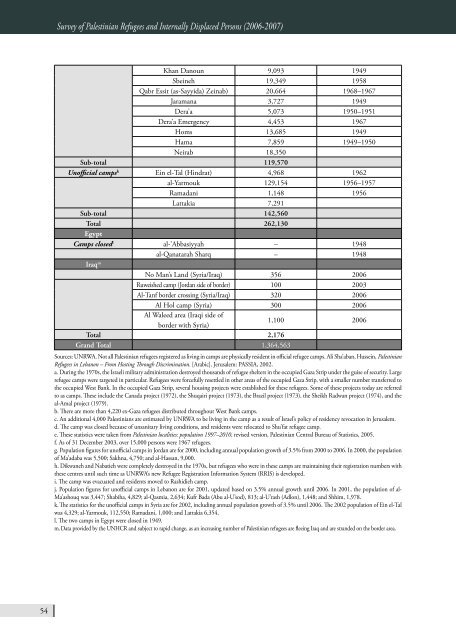BADIL Resource Center for Palestinian Residency and Refugee
BADIL Resource Center for Palestinian Residency and Refugee
BADIL Resource Center for Palestinian Residency and Refugee
Create successful ePaper yourself
Turn your PDF publications into a flip-book with our unique Google optimized e-Paper software.
54<br />
Survey of <strong>Palestinian</strong> <strong>Refugee</strong>s <strong>and</strong> Internally Displaced Persons (2006-2007)<br />
Khan Danoun 9,093 1949<br />
Sbeineh 19,349 1958<br />
Qabr Essit (as-Sayyida) Zeinab) 20,664 1968–1967<br />
Jaramana 3,727 1949<br />
Dera’a 5,073 1950–1951<br />
Dera’a Emergency 4,453 1967<br />
Homs 13,685 1949<br />
Hama 7,859 1949–1950<br />
Neirab 18,350<br />
Sub-total 119,570<br />
Unofficial campsk Ein el-Tal (Hindrat) 4,968 1962<br />
al-Yarmouk 129,154 1956–1957<br />
Ramadani 1,148 1956<br />
Lattakia 7,291<br />
Sub-total 142,560<br />
Total<br />
Egypt<br />
262,130<br />
Camps closedl al-’Abbasiyyah – 1948<br />
Iraq<br />
al-Qanatarah Sharq – 1948<br />
m<br />
No Man’s L<strong>and</strong> (Syria/Iraq) 356 2006<br />
Ruweished camp (Jordan side of border) 100 2003<br />
Al-Tanf border crossing (Syria/Iraq) 320 2006<br />
Al Hol camp (Syria) 300 2006<br />
Al Waleed area (Iraqi side of<br />
border with Syria)<br />
1,100 2006<br />
Total 2,176<br />
Gr<strong>and</strong> Total 1,364,563<br />
Sources: UNRWA. Not all <strong>Palestinian</strong> refugees registered as living in camps are physically resident in official refugee camps. Ali Sha’aban, Hussein, <strong>Palestinian</strong><br />
<strong>Refugee</strong>s in Lebanon – From Hosting Through Discrimination. [Arabic]. Jerusalem: PASSIA, 2002.<br />
a. During the 1970s, the Israeli military administration destroyed thous<strong>and</strong>s of refugee shelters in the occupied Gaza Strip under the guise of security. Large<br />
refugee camps were targeted in particular. <strong>Refugee</strong>s were <strong>for</strong>cefully resettled in other areas of the occupied Gaza Strip, with a smaller number transferred to<br />
the occupied West Bank. In the occupied Gaza Strip, several housing projects were established <strong>for</strong> these refugees. Some of these projects today are referred<br />
to as camps. These include the Canada project (1972), the Shuqairi project (1973), the Brazil project (1973), the Sheikh Radwan project (1974), <strong>and</strong> the<br />
al-Amal project (1979).<br />
b. There are more than 4,220 ex-Gaza refugees distributed throughout West Bank camps.<br />
c. An additional 4,000 <strong>Palestinian</strong>s are estimated by UNRWA to be living in the camp as a result of Israel’s policy of residency revocation in Jerusalem.<br />
d. The camp was closed because of unsanitary living conditions, <strong>and</strong> residents were relocated to Shu’fat refugee camp.<br />
e. These statistics were taken from <strong>Palestinian</strong> localities: population 1997–2010, revised version, <strong>Palestinian</strong> Central Bureau of Statistics, 2005.<br />
f. As of 31 December 2003, over 15,000 persons were 1967 refugees.<br />
g. Population figures <strong>for</strong> unofficial camps in Jordan are <strong>for</strong> 2000, including annual population growth of 3.5% from 2000 to 2006. In 2000, the population<br />
of Ma’adaba was 5,500; Sakhna, 4,750; <strong>and</strong> al-Hassan, 9,000.<br />
h. Dikwaneh <strong>and</strong> Nabatieh were completely destroyed in the 1970s, but refugees who were in these camps are maintaining their registration numbers with<br />
these centres until such time as UNRWA’s new <strong>Refugee</strong> Registration In<strong>for</strong>mation System (RRIS) is developed.<br />
i. The camp was evacuated <strong>and</strong> residents moved to Rashidieh camp.<br />
j. Population figures <strong>for</strong> unofficial camps in Lebanon are <strong>for</strong> 2001, updated based on 3.5% annual growth until 2006. In 2001, the population of al-<br />
Ma’ashouq was 3,447; Shabiha, 4,829; al-Qasmia, 2,634; Kufr Bada (Abu al-U’sod), 813; al-U’rash (Adlon), 1,448; <strong>and</strong> Shhim, 1,978.<br />
k. The statistics <strong>for</strong> the unofficial camps in Syria are <strong>for</strong> 2002, including annual population growth of 3.5% until 2006. The 2002 population of Ein el-Tal<br />
was 4,329; al-Yarmouk, 112,550; Ramadani, 1,000; <strong>and</strong> Lattakia 6,354.<br />
l. The two camps in Egypt were closed in 1949.<br />
m. Data provided by the UNHCR <strong>and</strong> subject to rapid change, as an increasing number of <strong>Palestinian</strong> refugees are fleeing Iraq <strong>and</strong> are str<strong>and</strong>ed on the border area.

















